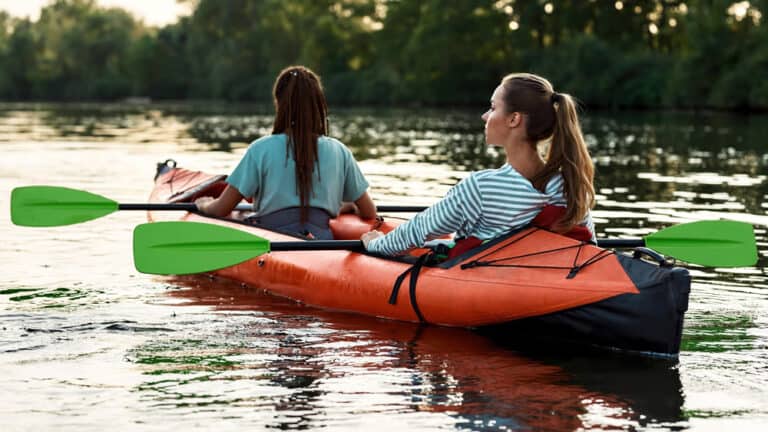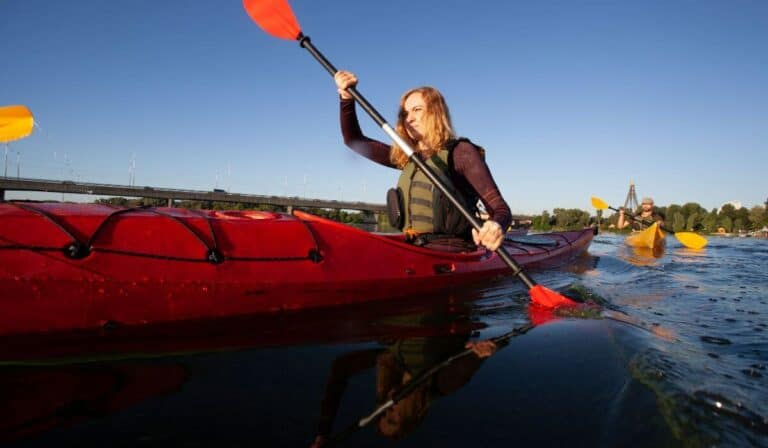How To Use A Tandem Kayak (2023)
Embarking on a voyage to master the art of tandem kayaking can be an energizing and gratifying experience. Tandem kayaks offer unique opportunities for teamwork, communication, and shared exploration with friends or family members. To start, we’ll provide guidance on selecting the ideal tandem kayak for your adventure and preparing to hit the water safely.
We will begin by discussing the process of choosing the right tandem kayak for your needs. Next, we’ll cover important preparation steps before embarking on your trip. As you progress through our guide, you’ll gain valuable insight into effective paddling techniques that are crucial for maintaining control and maneuverability in a tandem kayak.
Furthermore, we’ll explore various strategies for navigating on the water while working together as a team. Finally, we’ll provide some suggestions on how to make the most out of your tandem kayaking experience so that it becomes an unforgettable adventure filled with lasting memories.
Table of Contents
Choosing the Right Tandem Kayak

Exploring the outdoors with a companion can be made easier and more enjoyable through tandem kayaking. Selecting the appropriate tandem kayak for your requirements may be a challenge. To ensure you get the most out of your outdoor adventure, it’s essential to be knowledgeable about the different varieties and features of tandem kayaks.
The first type of tandem kayak is a sit-on-top model. These boats have two cockpits that allow two people to sit side by side while paddling together. Sit-on-top tandem kayaks are ideal for recreational use, particularly by those new to the sport or families with young children looking to spend time on the water.
Another option is a touring tandem kayak, which has two separate cockpits in front and back so that each person can paddle independently without interfering with their partner’s strokes. This type of boat is designed for longer trips when more speed and maneuverability are needed than what’s offered by a sit-on-top model. Touring tandems also tend to be narrower than recreational models, allowing them to slice through waves more easily and cover greater distances faster.
If you plan on taking overnight trips in your tandem kayak, then consider investing in an inflatable version instead – these kayaks offer all the same features as regular tandems but fold up into compact packages that make storage much easier when not in use. Inflatable models also come equipped with built-in air chambers so if any part gets punctured during your trip, you won’t have to worry about sinking or having too little buoyancy left over once you reach shore again safely.
Finally, don’t forget about comfort when selecting your new boat – choose one that offers adjustable footrests and seatbacks so both passengers can find their perfect fit before hitting the water. Also look out for features like extra dry storage compartments (for keeping items like snacks dry) as well as handles along either side of the cockpit (which makes carrying it around much easier). With these tips in mind, you’ll be able to set off on your next adventure feeling confident knowing you’ve chosen just the right tandem kayak for yourself and whoever else will join you along this journey.
Choosing the right tandem kayak is essential to having a successful and enjoyable experience. Preparing thoroughly is key to having a safe and enjoyable outing with your tandem kayak. Now let’s look at how to prepare for your upcoming adventure.
The Key Takeaway: When selecting a tandem kayak for your outdoor adventure, consider the type of boat (sit-on-top or touring) as well as its comfort and storage features to ensure you get just the right one. Look out for adjustable footrests and seatbacks plus extra dry compartments so that everyone can have an enjoyable time on the water.
Preparing for Your Trip

Packing the Right Gear:
When it comes to tandem kayaking, having the right gear is essential. Make sure you have two paddles, life jackets for both people in the kayak, a whistle or signaling device, and a first aid kit. You’ll also want to bring along sunscreen and insect repellent if needed. Ensure your kayak is fully outfitted with all the necessary components such as ties and seat pads. Bring along some water and treats for the journey.
Safety Precautions:
Before heading out on any kind of adventure like tandem kayaking it’s always important to check the weather conditions beforehand so you can be prepared for anything Mother Nature throws at you.
Click here to read our article on kayaking safety
Also remember that even though tandem kayaks are designed for two people they can still capsize easily so make sure everyone knows how to swim before setting off on your trip. Before departing, make sure to let someone know your plan in case of any unforeseen circumstances while kayaking.
Navigating The Water:
Navigating through waterways requires knowledge of basic navigational skills including reading maps and using compasses or GPS devices when available. Remaining mindful of possible risks, such as rocks or logs, is essential to steer clear of them while sailing around rivers or lakes. Additionally, pay attention to signs posted by local authorities regarding areas that may be closed due to special events or environmental concerns.
Once all the precautions have been taken, nothing remains but to savor the outdoors. Take some pictures along the way so you can capture memories from this experience forever; after all, what better way than capturing nature with a camera? And most importantly, take time during each paddle stroke to appreciate every moment because these adventures will only come once in a lifetime.
Readying oneself for a voyage is fundamental to guarantee an enjoyable and secure outing. It’s now the moment to acquire knowledge of paddling skills so you can venture out onto the lake.
The Key Takeaway: Before heading out on a tandem kayaking adventure, make sure to pack the right gear and take all necessary safety precautions such as checking the weather conditions and informing someone of your whereabouts. Once properly prepared, navigate waterways with knowledge of basic navigational skills while taking time to appreciate every moment – because these adventures come once in a lifetime.
Paddling Techniques

Paddling a tandem kayak is an exciting way to explore the outdoors. Whether you’re heading out for a day trip or a multi-day excursion, proper paddling techniques will help ensure your journey is enjoyable and safe.
The first step in learning how to paddle effectively is understanding the different types of strokes available. The most common stroke used when paddling a tandem kayak is called the J-Stroke, which helps keep your boat moving straight ahead with minimal effort from both paddlers. To execute this stroke, start by pushing your paddle blade into the water at an angle toward the bow of your boat. Then rotate it so that it’s parallel to the surface of the water and pull back until it reaches just behind you. This motion should create an “S” shape in front of you as you move forward through the water.
Both paddlers must work in tandem to execute the Reverse Stroke or Sweeping Stroke, which is used to make quick and efficient turns without losing speed or momentum. Pulling back on their oars with equal force and timing on opposite sides of their respective boats will enable them to navigate around obstacles like rocks or logs floating downstream. To ensure success, it’s important for both paddlers to be in sync. Keywords: Paddling, Tandem Kayak, J-Stroke, Reverse Stroking/Sweeping Stroke, Navigation
For those tougher conditions, you can use the High Bracing Technique to give yourself an extra boost of power. This involves gripping your paddle shaft close enough to enable you to push down hard against any waves that come up from underneath while simultaneously holding onto either side edge railings near where each person sits – providing stability and propulsion for a successful journey. Keywords: Paddling, Tandem Kayak, J-Stroke, Reverse Stroking/Sweeping Stroke, Navigation, High Bracing Technique
By mastering these three essential strokes – J-stroke, reverse stroking/sweeping stroke, and high bracing – anyone can enjoy hours upon hours exploring planet earth on board their own personal vessel.
Paddling techniques are essential to having a successful and enjoyable time on the water. With proper navigation, you can maximize your kayaking experience while exploring new areas with confidence.
The Idea: Experienced paddlers can enjoy the outdoors and navigate around obstacles using a tandem kayak by mastering three essential strokes – J-stroke, reverse stroking sweeping stroke, and high bracing. With these techniques under their belt, they’ll be able to cruise through any conditions with ease.
Navigating on the Water

Navigating on the Water is an important skill for any tandem kayaker. It’s essential to understand currents, identify hazards, and stay safe while out on the water. To ensure a successful journey, it’s important to plan ahead and know what to look for when navigating in a tandem kayak.
Reading Currents:
Before heading out onto the water, it’s important to be aware of any current that may exist in your area. Look for ripples or waves moving in one direction or another as this could indicate a current you need to take into account when planning your route. If possible, ask local paddlers about potential currents they have encountered so you can prepare accordingly.
Identifying Hazards:
When out on the water there are many hazards that can pose risks such as submerged rocks and other obstacles like logs or branches that could damage your boat if not seen early enough. Pay attention to changes in depth and use binoculars if necessary; scanning ahead will help you spot any potential dangers before they become too close for comfort. Additionally, watch out for strong winds which can make navigation more difficult than usual – especially with a tandem kayak since two people will be paddling together.
Staying Safe:
While navigating in a tandem kayak always wear life jackets and carry safety equipment such as flares or whistles should an emergency arise during your trip. Be sure both passengers are familiar with how to operate their side of the boat safely so no one gets injured due to inexperience or lack of knowledge about proper technique. Additionally keep an eye on weather conditions at all times; sudden storms can quickly turn dangerous so being prepared is key. Lastly don’t forget basic navigation skills like using compasses and charts which are invaluable tools when trying navigate unfamiliar waters.
By understanding these basics of navigating on the water with a tandem kayak, adventurers will feel confident knowing they are well-prepared before setting off on their next outdoor adventure. With knowledge of currents, identification of hazards, and safety protocols in place, paddlers can be sure that their journey will be an enjoyable one.
Before embarking on your journey, it is essential to ensure safety by taking necessary precautions. With that in mind, let’s move onto enjoying your adventure.
The Idea: Navigating a tandem kayak requires an understanding of currents, identification of hazards, and preparation for potential emergencies. Before embarking on your next outdoor adventure, it is prudent to familiarize yourself with the local environment and plan accordingly.
Enjoying Your Adventure
When it comes to enjoying your tandem kayaking adventure, there are a few key tips and tricks that can make the experience even more enjoyable. Take breaks to stretch and explore the beauty of nature around you. During these breaks, be sure to stretch out any tight muscles or sore joints before continuing on with your journey. Additionally, if possible, plan ahead and try to find interesting places along the way where you can explore during these rest stops. This could include stopping at a beach or small island for some swimming or snorkeling activities.
It’s also important to keep hydrated while out on the water; bring plenty of bottled water so that everyone stays refreshed throughout their journey. You should also pack some snacks such as energy bars and trail mix which will help give an extra boost when needed. Finally, remember that tandem kayaking is all about having fun – so don’t forget to enjoy yourself. Take time to relax and appreciate all of the amazing sights that come with being out on the open water together with someone else; this will make memories last forever.
Take your tandem kayaking adventure to the next level with these tips: regular breaks, plan ahead, hydrate & snack. Enjoy nature and make memories.
FAQs About How to Use a Tandem Kayak
How do you use a tandem kayak?
Tandem kayaking is a great way to explore the outdoors with a partner. To get started, two people should sit in the boat facing each other. One person will be in charge of steering while the other provides power by paddling on one side of the boat.
It’s important to synchronize your strokes so that you both paddle at an even pace and move forward efficiently. When turning or navigating obstacles, communication between partners is key for successful maneuvering. With practice, tandem kayaking can be an enjoyable experience for all involved.
Do you paddle on the same side in a tandem kayak?
In a tandem kayak, both paddlers must paddle on the same side in order to move forward efficiently. One must paddle on the left, the other on the right; synchronizing their strokes for maximum efficiency.
It is important for both people in the boat to coordinate their strokes so they are moving together as one unit. Proper technique and communication between partners can help make your time spent out on the water more enjoyable and successful.
Is a tandem kayak good for beginners?
Tandem kayaks can be a great option for beginners. Tandem kayaks provide a perfect platform for beginners to gain confidence and skills while enjoying the water with another person.
Tandem kayaks also provide an opportunity to learn with someone else, which can make learning more enjoyable and increase safety on the water. With proper instruction and practice, tandem kayaking is an accessible activity that anyone can enjoy.
How do you get in and out of a tandem kayak?
Getting in and out of a tandem kayak is simple but requires some coordination. Start by sitting on the back seat with your legs inside the cockpit. Then, slide forward so that you are centered between both seats.
Reach behind you to grab the front seat and pull it towards you until it’s close enough for your partner to get in easily. To exit, carefully turn around while holding onto the edges of each side of the kayak, then lift yourself up from one side at a time until you’re standing outside of it.
Conclusion
With some preparation, knowledge of paddling techniques, and navigation skills you can ensure your adventure is safe and fun for everyone involved. Whether it’s a calm lake or rough river that awaits you, use a tandem kayak to make memories with friends or family that will last forever.
Discover the best tips and tricks for using a tandem kayak with SunWaterDirt.com, your go-to resource for outdoor adventure advice! Learn how to safely navigate any body of water in a two-person boat today.







